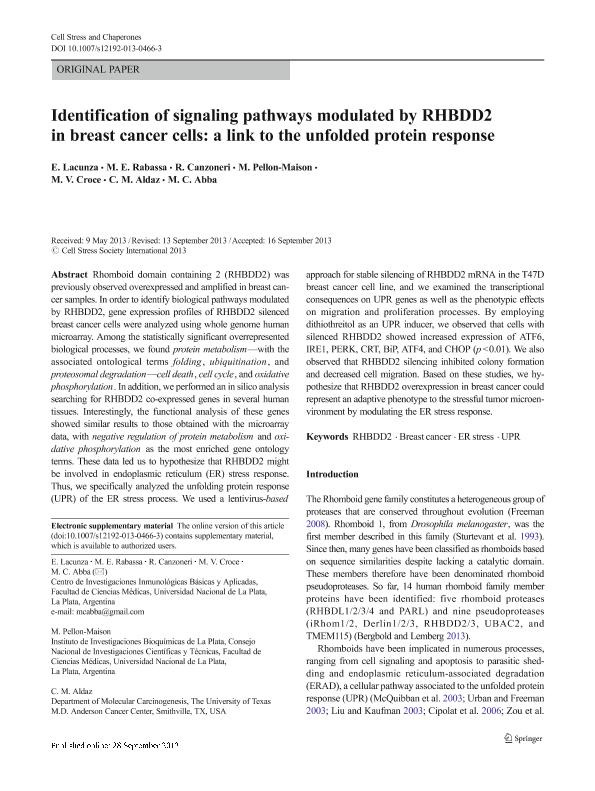Mostrar el registro sencillo del ítem
dc.contributor.author
Lacunza, Ezequiel

dc.contributor.author
Rabassa, Martín Enrique

dc.contributor.author
Canzoneri, Romina

dc.contributor.author
Pellon Maison, Magali

dc.contributor.author
Croce, María Virginia

dc.contributor.author
Aldaz, Claudio Marcelo

dc.contributor.author
Abba, Martín Carlos

dc.date.available
2018-01-08T14:31:59Z
dc.date.issued
2014-05
dc.identifier.citation
Lacunza, Ezequiel; Rabassa, Martín Enrique; Canzoneri, Romina; Pellon Maison, Magali; Croce, María Virginia; et al.; Identification of signaling pathways modulated by RHBDD2 in breast cancer cells: a link to the unfolded protein response; Springer; Cell Stress & Chaperones.; 19; 3; 5-2014; 379-388
dc.identifier.issn
1355-8145
dc.identifier.uri
http://hdl.handle.net/11336/32511
dc.description.abstract
Rhomboid domain containing 2 (RHBDD2) was previously observed overexpressed and amplified in breast cancer samples. In order to identify biological pathways modulated by RHBDD2, gene expression profiles of RHBDD2 silenced breast cancer cells were analyzed using whole genome human microarray. Among the statistically significant overrepresented biological processes, we found protein metabolism—with the associated ontological terms folding, ubiquitination, and proteosomal degradation—cell death, cell cycle, and oxidative phosphorylation. In addition, we performed an in silico analysis searching for RHBDD2 co-expressed genes in several human tissues. Interestingly, the functional analysis of these genes showed similar results to those obtained with the microarray data, with negative regulation of protein metabolism and oxidative phosphorylation as the most enriched gene ontology terms. These data led us to hypothesize that RHBDD2 might be involved in endoplasmic reticulum (ER) stress response. Thus, we specifically analyzed the unfolding protein response (UPR) of the ER stress process. We used a lentivirus-based approach for stable silencing of RHBDD2 mRNA in the T47D breast cancer cell line, and we examined the transcriptional consequences on UPR genes as well as the phenotypic effects on migration and proliferation processes. By employing dithiothreitol as an UPR inducer, we observed that cells with silenced RHBDD2 showed increased expression of ATF6, IRE1, PERK, CRT, BiP, ATF4, and CHOP (p < 0.01). We also observed that RHBDD2 silencing inhibited colony formation and decreased cell migration. Based on these studies, we hypothesize that RHBDD2 overexpression in breast cancer could represent an adaptive phenotype to the stressful tumor microenvironment by modulating the ER stress response.
dc.format
application/pdf
dc.language.iso
eng
dc.publisher
Springer

dc.rights
info:eu-repo/semantics/openAccess
dc.rights.uri
https://creativecommons.org/licenses/by-nc-sa/2.5/ar/
dc.subject
Rhbdd2
dc.subject
Breast Cancer
dc.subject
Er Stress
dc.subject
Upr
dc.subject.classification
Genética Humana

dc.subject.classification
Medicina Básica

dc.subject.classification
CIENCIAS MÉDICAS Y DE LA SALUD

dc.title
Identification of signaling pathways modulated by RHBDD2 in breast cancer cells: a link to the unfolded protein response
dc.type
info:eu-repo/semantics/article
dc.type
info:ar-repo/semantics/artículo
dc.type
info:eu-repo/semantics/publishedVersion
dc.date.updated
2017-12-26T14:29:46Z
dc.journal.volume
19
dc.journal.number
3
dc.journal.pagination
379-388
dc.journal.pais
Alemania

dc.journal.ciudad
Berlin
dc.description.fil
Fil: Lacunza, Ezequiel. Consejo Nacional de Investigaciones Científicas y Técnicas; Argentina. Universidad Nacional de La Plata. Facultad de Ciencias Médicas. Centro de Investigaciones Inmunológicas Básicas y Aplicadas; Argentina
dc.description.fil
Fil: Rabassa, Martín Enrique. Universidad Nacional de La Plata. Facultad de Ciencias Médicas. Centro de Investigaciones Inmunológicas Básicas y Aplicadas; Argentina
dc.description.fil
Fil: Canzoneri, Romina. Consejo Nacional de Investigaciones Científicas y Técnicas; Argentina. Universidad Nacional de La Plata. Facultad de Ciencias Médicas. Centro de Investigaciones Inmunológicas Básicas y Aplicadas; Argentina
dc.description.fil
Fil: Pellon Maison, Magali. Consejo Nacional de Investigaciones Científicas y Técnicas. Centro Científico Tecnológico Conicet - La Plata. Instituto de Investigaciones Bioquímicas de La Plata "Prof. Dr. Rodolfo R. Brenner". Universidad Nacional de la Plata. Facultad de Ciencias Médicas. Instituto de Investigaciones Bioquímicas de La Plata ; Argentina
dc.description.fil
Fil: Croce, María Virginia. Consejo Nacional de Investigaciones Científicas y Técnicas; Argentina. Universidad Nacional de La Plata. Facultad de Ciencias Médicas. Centro de Investigaciones Inmunológicas Básicas y Aplicadas; Argentina
dc.description.fil
Fil: Aldaz, Claudio Marcelo. University of Texas; Estados Unidos
dc.description.fil
Fil: Abba, Martín Carlos. Consejo Nacional de Investigaciones Científicas y Técnicas; Argentina. Universidad Nacional de La Plata. Facultad de Ciencias Médicas. Centro de Investigaciones Inmunológicas Básicas y Aplicadas; Argentina
dc.journal.title
Cell Stress & Chaperones.

dc.relation.alternativeid
info:eu-repo/semantics/altIdentifier/doi/http://dx.doi.org/10.1007/s12192-013-0466-3
dc.relation.alternativeid
info:eu-repo/semantics/altIdentifier/url/https://link.springer.com/article/10.1007%2Fs12192-013-0466-3
Archivos asociados
